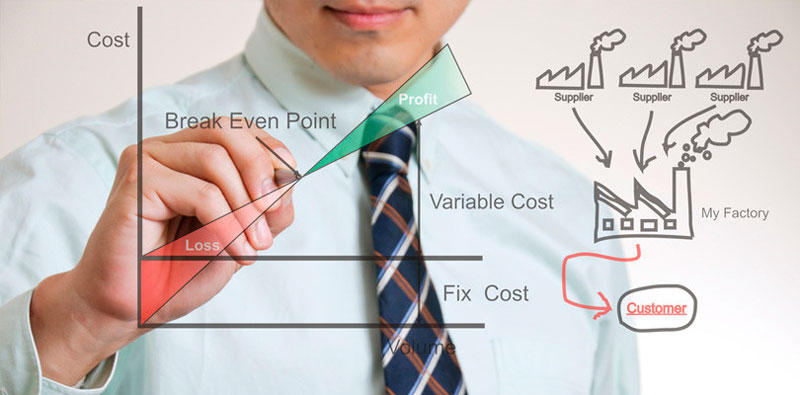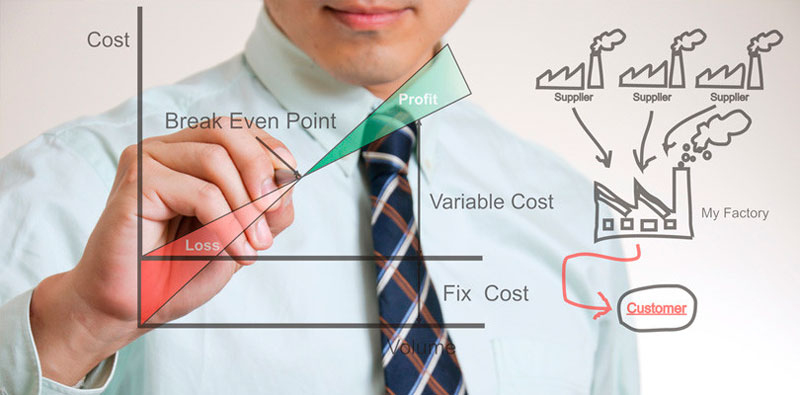Determine the financial break-even point It is what allows any type of business or company to establish the level of sales it needs to make so that in principle it can meet the total costs.
In simple words, it is an essential tool for the company to use as a strategy that allows it to know if the business is solvent and if there is profitability.
Basics of the financial breakeven point
Fixed costs
The financial break-even point has basic aspects such as fixed costs that have nothing to do with the operations of the business, or with the business, or with the running of the business, since they are costs that must be faced despite the fact that the Whether the business works or not, examples of fixed costs are telephony, electricity, water, renting a business premises, etc.
In other words, even though the business has not presented sales, those fixed costs will always be present.
They have a horizontal value because they are constant despite the passing of time because they have been fixed at the time of the contract, such as amortizations, depreciation of wages, income, etc.
Variable costs
Variable costs are different from fixed costs because they do have to do with the running of the business, for example they are raw materials, products for sale among others. Their proportion is variable because they are directly related to the level of sales and production. There must be a contribution margin because it will be the positive difference between the sale price and the purchase price.
It increases according to the activity with a positive slope on the graph. Adding fixed costs with variable costs will result in a result as total costs.
What is the financial breakeven point?
You get to determine what the financial break-even point if the costs and costs that influence a production process are identified.
It begins by identifying the cost related to production and its volume, taking into account what expenses and costs can be variable or fixed.
Operating costs
Operating costs are those that have no variation. They are related to the level of production and that can be recovered with the operation.
Fixed operating expenses
Fixed operating expenses are those needed for the sale of the products until they reach the consumer. They are indirectly related to production. They are needed to recover operational costs.
It is the study of the relationship between fixed costs and expenses, variable costs and expenses, operating profits and sales volume.
It is the level of sales and production that the business achieves so that costs and expenses are covered from the income it obtained.
Example of a financial break-even point
- CF means fixed costs.
- PVq means unit selling price.
- CVq, means unit variable cost.
So in a factory different types of materials are needed depending on the model of the product to be manufactured, raw materials, tools, etc. At the same time there will be indirect costs such as indirect labor.
It is determined that for the production of a specific model a value of 90,000 is needed for the production of a unit equivalent to the finished product.
The necessary tools with a value of 70 million with a depreciation to 10 years. A cost of 43 million was stipulated for the commercial premises of the factory with a depreciation of 20 years.
Labor is set at 30,000 for each unit manufactured with manufacturing overhead calculated at 20,000 for each unit produced.
The sale price of each unit is established, which is determined at a value of 180,000. The administration payroll is established for a value of 6 million per month with a sales commission of 10%
This question must be asked: what is the number of units that need to be produced so that operational losses are not caused, and it is necessary to establish the financial equilibrium point of the company.
The total value of the annual fixed expenses and the total costs are determined by adding the administration payroll, the depreciation of the tools and the depreciation of the plant.
The total variable expenses per unit and the total costs per unit are determined by adding the commission per sale, indirect manufacturing costs, direct materials and labor.
Then the contribution of each unit sold is analyzed according to the value obtained, which should cover fixed costs in addition to profits.
Financial breakeven formula
To establish the point of financial equilibrium, this formula can be carried out:
PE = Fixed costs over P minus CV
Where CF, corresponds to fixed costs, P, means unit price and CV, means unit variable costs.
It can also be done from the following formula:
Pi = CF + (CVu * Qi
Where Pi means the price of the products in quantity; CVM stands for variable cost of each product; Qi means quantity of production and C means fixed costs.
The operating and financial equilibrium formula is
In units: PEO = CFT / CVU – PVU
PEF = CFT + GF / CVU -PVU
Where PEO is the operating breakeven point; CFT, means total fixed costs; CVU, means financial expenses; PVU is the unit sale price; GF, is overhead.
In a nutshell Operating breakeven point equal to fixed costs divided by 1 (variable costs divided by net sales)
And the financial breakeven point is equal to fixed costs + financial expenses divided 1- (variable costs divided net sales.
For example, if a company wants to make this calculation knowing that the fixed costs have a value of 10,000, the variable costs have a value of 2 for each units produced and the sale price is 4 for each unit sold, based on the formula , have:
- CF 10000
- CVu = 2
- PVu = 4
- Then PEu = 10000 divided 4-2


